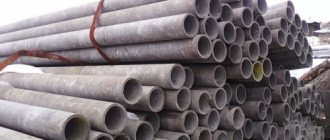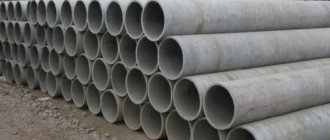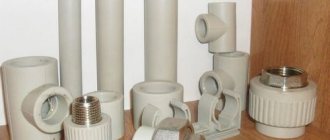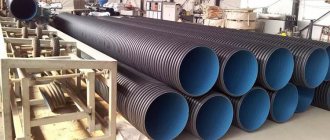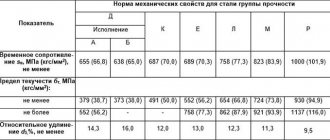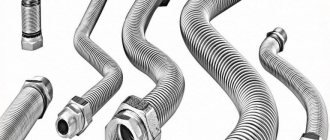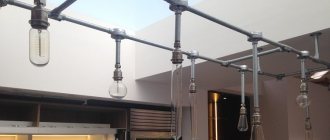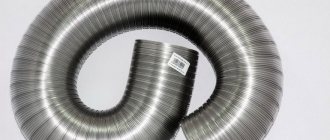Since 2014, GOST 50827-95 is not valid in the Russian Federation. New document - GOST 32126.1-2013
To protect cables from damage in construction, corrugated electrical pipes made of PVC are used. They serve as reliable insulation and meet strict fire safety requirements. In the event of a short circuit, such products do not support the spread of flame and do not emit toxic compounds. Used for open and closed laying of power electrical, telephone and information insulated wires.
Application of corrugated electrical pipes
The light series of GOST 50827-95 pipes are lightweight and create minimal load on the support. It is used for organizing wiring in suspended ceilings and in the voids of false structures.
The heavy and super-heavy series, due to their thicker walls, have greater weight and can withstand greater mechanical loads. They are used for underground work and in monolithic construction for hidden installations filled with concrete mortar.
Networks organized using GOST 50827-95 pipes are designed for a long service life. Electrical corrugations are used in residential, office and industrial premises; they allow laying cables in a building of any geometry.
Double wall corrugated products
A feature of double-wall pipes is increased rigidity. Such products are used to protect wiring and cable lines that are laid underground. Due to the smoothness of the inner layer, minimal friction is ensured, which is important not only for ease of installation, but also for durability of use.
Double-layer, as well as single-layer, pipes are produced with diameters of 160, 63, 90, 50, 125, 200, 110 millimeters and are supplied in coils of 100, 50 or 40 meters. Corrugated products are supplied with connecting and fastening accessories, which are represented by brackets, tees, couplings, bends, clips, and terminals. Adapters are available in sizes 75-90, 90-110, 110-125, 125-140, 140-160 and 160-200 mm.
The parameters of double-wall pipes with and without broaching are shown in the table.
table 2
| Inner diameter, * 10 mm | External diameter, *10 mm | Ring stiffness, not less, kPa |
| 4,15 | 5,0 | 13,3 |
| 5,15 | 6,3 | 13,5 |
| 6,25 | 7,5 | 10,5 |
| 7,7 | 9,0 | 6,2 |
| 9,4 | 11,0 | 8,0 |
| 10,7 | 12,0 | 5,4 |
| 12,0 | 14,0 | 5,0 |
| 13,7 | 16,0 | 6,6 |
| 17,2 | 20,0 | 6,5 |
Flexible double-walled products can be used as a cable channel up to 0.01 MV in the ground, as well as when installing free-flow storm drainage systems.
In addition to electrical networks, heavy pipes are successfully used in storm, drainage and sewer systems
Technical characteristics of products according to GOST 50827-95 (IEC 670-89)
Electrical corrugated pipes, like any other material, have certain characteristics.
The technical characteristics of this type of profile are listed in Table 1. Table 1 Technical characteristics of electrical corrugated pipes according to GOST 50827-95 (IEC 670-89)
| Material | Self-extinguishing polymer composite |
| Color | RAL 7035, gray |
| Degree of protection | IP 55 GOST 14254 (IEC 529-89) |
| Installation temperature | from -5°C to +60°С |
| Operating interval | from -25°С to +60°С |
| Mechanical strength of light series pipe | 350 H per 5 cm at +20°C |
| Mechanical strength of heavy series pipe | 720 H per 5 cm at +20°C |
| Dielectric strength | 2000B |
| Insulation resistance | 100 MOhm |
| Fire resistance | up to +650°С |
Marking of HDPE pipes - its features
Information in the form of letters and symbols is applied to the outer surface of PE pipes, which contains technical data of the products. Markings must be clear, legible, contrasting with the color of the pipe, and resistant to abrasion. It contains the following information:
- name of the manufacturer or company trademark;
- pipe material (PE), grade of polyethylene;
- nominal diameter and wall thickness in mm;
- SDR value;
- purpose of the product (plumbing, gas);
- production standards, GOST;
- batch and line number, production date.
Note!
The name of the material is indicated in the international format - for example, PE 100 (PE 100). The successful selection of a suitable product, which will protect against many errors during pipeline installation, depends largely on the ability to correctly read the markings.
What should be the durability of pipe connections according to GOST?
The main methods of connecting polyethylene pipes are:
- mechanical - through fittings;
- welded joint.
The type of connection used depends on the purpose of the pipeline, the pressure in it and the diameter of the product. The resistance indicators of PE pipe connections are regulated by the rules of GOST R ISO 12176-4-2014.
The durability of the welded joint is checked for 165 hours at a temperature of 80⁰C and a stress of 4.5 MPa for PE 80 pipes and 5.4 MPa for PE 100 products.
Mechanical connections are checked for an hour at a temperature of 20⁰C at a nominal pressure increased by 1.5 times. These connections are also tested for tensile load, which is calculated based on the formula
RN = 1.5 x N x π x (ND-TS) x TS, where RN is the tensile load, N is the permissible stress value (8 MPa for PE 80 pipes, 10 MPa for PE 100 pipes), ND is the nominal outer diameter , TC – average pipe wall thickness. You can use the table to select pressure ratings
| SDR | Nominal pressure value, x10-1 | |
| PE 80 | PE 100 | |
| 41 | 32 | 40 |
| 33 | 40 | 50 |
| 26 | 50 | 60 |
| 21 | 60 | 80 |
| 17 | 80 | 100 |
| 13,6 | 100 | 125 |
| 11 | 125 | 160 |
Table of pressure ratings for mechanical connections
If the connection is made using compression fittings, the following data should be taken into account when testing the pressure.
| Test temperature, ⁰C | Time, no | Pressure for fittings, material | ||||
| PP-R | PP-B | PP-H | P.O.M. | ABS | ||
| 20 | 1000 h | 1.2 x OD | 1.5 x OD | |||
| 40 | 0.8 x OD | 1.1 x OD | ||||
Data table for use in calculations when using compression fittings
Important!
Compression fittings are used to connect PE pipes with a diameter of no more than 110 mm. The main areas of application of such compounds are irrigation systems in agriculture and drinking water supply.
Technical requirements for HDPE pipes
For standardized PE pipes, the presence of visual defects on either the external or internal surfaces is unacceptable. The walls must be smooth, without foreign inclusions, voids, swelling or cracks. GOST 32415 allows only slight waviness and the presence of stripes running along the product.
According to this standard, the resistance of HDPE pipes to internal pressure is determined by testing, the parameters of which are given in the table below.
| No. | Test time, min., not less | Temperature, in ⁰C | Hoop (hydrostatic) stress for PE brand, kPa | |
| 100 | 80 | |||
| 1 | 6 thousand | 20 | 12 thousand | 10 thousand |
| 2 | 165*60 | 80 | 5400 | 4500 |
| 3 | 60 thousand | 80 | 5 thousand | 4 thousand |
Table with parameters of initial tests of pipe resistance indicators according to GOST 32415
If plastic failure occurs, PE pipes are subjected to repeated tests, the conditions of which are given below.
| PE 100 | |
| Hydrostatic stress, kPa | Time, h |
| 5400 | 165 |
| 5300 | 256 |
| 5200 | 399 |
| 5100 | 629 |
| 5 thousand | 1 thousand |
| — | — |
Table with parameters of repeated (in case of failure of the first) tests of resistance indicators of polyethylene pipes in accordance with GOST 32415
I would like to note certain points regarding the tests:
- After heating to a temperature of 108 -112⁰C, PE pipes for water supply can elongate: the permissible elongation value is 3%. Tests for products with a wall thickness of up to 8 mm last 58-62 minutes, up to 16 mm - 118-122 minutes, above - 238-242 minutes.
- Grade PE 100 must have an elongation at break of at least 350%.
- The fluidity index in comparison with the initial state changes by no more than 20%, heat resistance at t 20⁰С – from 20 minutes.
Note!
The weight of HDPE pipes is usually not taken into account: in any case, such products are lighter than metal products. However, when transporting large quantities of pipes or developing a structure with minimal loads, this indicator should not be neglected.
Installation of electrical corrugated pipes
Due to its flexibility, PVC electrical corrugation can be laid in almost any turns and bends, using a minimum number of additional fasteners.
At the junctions of straight sections of material, special couplings are used. Pipes are attached to various surfaces using clips or brackets designed for different corrugation diameters. For a product with a diameter of 16 mm, fasteners are placed at a distance of 35–40 cm; a pipe with a diameter greater than 32 mm requires more frequent fastening, at least 25 cm from each other. The branching of the main takes place in the installation boxes.
Before starting work, mark the location of the pipe ends near the electrical panels. Then they outline the wiring route, installation locations of junction boxes, and attachment points.
Installation of such products does not require special skills.
It is enough to follow the following rules:
- The electrical pipe is purged with compressed air.
- Cut to exactly measured length. The broach, if there is one, is cut and fixed so that it does not go into the cavity of the pipe.
- Attach the cable to the protruding end of the metal wire and pull it out from the opposite end of the corrugation. If there are several cables, they are fixed and then pulled together.
- To prevent the accumulation of condensate, it is recommended to lay corrugated pipes with a slight slope.
Installation work is carried out in the range from -5°C to 60°C. The use of corrugated PVC pipes for organizing electrical networks significantly speeds up their installation and facilitates maintenance and repair.
General installation requirements
- It is not recommended to lay networks for different purposes in the cavity of one pipe.
- When installing corrugation into a wall, it is first fixed, then filled with mortar, and after the final formation of the surface, the cable is pulled.
- You can lengthen the pipe section using a transit box installed in the center of the cable channel.
- The corners when laying should not be too sharp and follow each other to avoid the formation of creases.
- The working length of the pipe should not exceed 25 meters.
- For outdoor installation, a modification of black corrugated pipe, resistant to UV exposure, is used.
Modern construction technologies increasingly require the use of electrical corrugated PVC pipes to protect cables.
Do you have experience using similar products? Share your impressions in the comments.
Smooth PVC pipe
Smooth pipes are used for laying open-type power and low-current lines both inside buildings and structures, and in the open air.
Product out of stock
- Seal
Rigid smooth PVC pipes for electrical wiring
In general, smooth PVC pipes come in several types: casing, internal sewer, electrical, external sewer. All modifications differ in appearance, characteristics, and properties. For the convenience of users, all products have different colors; in addition, casing pipes are connected with threads, sewer pipes with sockets, and electrical fittings. Smooth-walled products of measured length have increased rigidity, both annular and longitudinal, which ensures a minimum amount of fasteners to the walls (relevant for electrical and sewer systems).
HDPE channels and their characteristics
GOST includes information about heavy and light pipes. This division is due to the difference in the degree of load on the products. The light series is usually laid to protect wiring or to compactly lay wires (cables) along walls. Heavy corrugated pipes are characterized by additional strength due to the thickness of the walls. Such products can be installed in concrete pouring or cement screed, underground, and other places where communications are required to withstand significant loads.
Heavy-duty pipes are most often double-walled; they are used for constructing underground networks at great depths
The products have a wide range of installation temperatures, which ranges from -40 to +90 degrees. The same temperatures apply to operating requirements. HDPE pipes come in different colors; they are black, yellow, gray, white, blue, orange.
The value of dielectric strength is not less than 2 kV or 50 Hz for 15 minutes, insulation resistance is not less than 0.1 GOhm or 0.5 kV for 1 minute.
Diameter of corrugated polyvinyl chloride pipes
The corrugation consists of rings of different diameters. As a rule, the difference between them is in the range from 5 to 12 mm. The difference in diameters must be taken into account when choosing a corrugated pipe.
Table 2 shows the outer and inner diameters of corrugated polyvinyl chloride pipes.
Table 2 Dimensions of electrical corrugated pipes
| External diameter, mm | Inner diameter, mm | Coil length, m |
| 16 | 10.7 | 100 or 50 |
| 20 | 14,1 | 100 or 50 |
| 25 | 18,3 | 50 or 25 |
| 32 | 24,3 | 50 or 25 |
| 40 | 32,5 | 15 |
| 50 | 39,6 | 15 |
| 63 | 50,6 | 15 |
To determine the required profile diameter, you need to know the exact number and diameter of the wires that will be placed in it. The empty space should be approximately half of the internal volume, otherwise pulling cables will be difficult or impossible.
The required diameter of electrical corrugated PVC pipes is determined based on the following requirements:
- 16 mm is used for connecting to lighting devices, for laying alarm and telephone networks.
- 20 mm – to switches and sockets.
- 20–25 mm – for organizing a coaxial network.
- 25 mm – connection of distribution boxes to each other and to the central distribution board. A backup line is recommended.
- 32 mm – connection between electrical panels. Additionally, a backup line is laid.
- 40, 50, 60 mm – for connection between floors.
Advantages of HDPE pipes
The widespread use of polyethylene pipes in various areas of industry, everyday life, and the national economy is due to their advantages over products made from other materials.
- Manufacturers give a warranty period of 50 years only to polyethylene pipes.
- HDPE pipes do not require cathodic protection, which means no additional maintenance.
- PE products are not susceptible to corrosion or aggressive chemicals.
- Lightweight polyethylene pipes, wound into coils, allow you to save on materials for installing the pipeline and time for its installation.
- PE water pipes can be installed repeatedly and are easily disposed of.
- By using butt welding, money is saved on pipeline installation.
- The use of PE pipelines guarantees the purity of the transported liquid, the absence of foreign odors and impurities.
- High elasticity allows you to withstand not only soil shifts, but also earthquakes.
Advantages of PE pipes compared to steel products
- When water freezes, the low modulus of elasticity prevents the destruction of the walls of polyethylene pipes, unlike steel products.
- The subsidence of the building where the communication runs can cause a violation of the integrity of the metal pipe, while HDPE pipes can withstand stretching up to 7% without losing integrity.
- Installation, maintenance and replacement of PE pipes are much more economical in terms of financial, time and labor costs.
- Polyethylene pipe does not belong to the category of dangerous goods.
- Polyethylene products are much lighter than metal ones - steel, cast iron: when laying, you can do without loading equipment.
- PE products are supplied, in addition to lengths, in coils; they are more convenient and less expensive to transport: in one trip you can transport 5 times more polyethylene pipes than metal ones.
- Due to the limited length of steel sections, it is necessary to make many joints per 1 km of pipeline (seams on metal are most vulnerable to corrosion) - the length of one section of PE pipe up to 110 mm in diameter in coils can be up to 2000 m. But butt welding of PE is cheaper and easier and faster, does not require highly qualified specialists.
- The outer diameter of polyethylene products, in contrast to steel communications, can vary from 20 to 1200 mm.
- PE pipes are more resistant to water hammer due to their high modulus of elasticity, in contrast to steel pipes.
- The ideally smooth inner surface of the polyethylene pipe walls prevents the formation of blockages and the deposition of impurities: over the years, the pressure in the PE pipe does not change.
- The thermal conductivity of PE products is lower than metal ones: when transporting cold water, the wall adjacent to the steel pipe is destroyed, but this will not happen with PE pipes.
- The maximum service life of steel pipes is 15-20 years, PE products – up to 50.
Attention!
Construction and repair of a pipeline from PE products makes it possible to save up to 40% of financial costs compared to the use of traditional metal pipes.
Advantages of PE pipes over metal-plastic products
- Polyethylene pipes, as well as fastening materials for connecting them, are much cheaper than metal-plastic products.
- The diameter sizes of metal-plastic pipes are limited - 16-63 mm, while PE communications can have a diameter from 20 to 1200 mm.
- PE connections are more durable (for example, for cross-linked polyethylene, special fixing sleeves are used to seal the junction of pipe parts). Metal-plastic products have an open connection between the fitting and the pipe, which over time can lead to leaks and leaks.
- Polyethylene pipes are more resistant to mechanical damage.
- Polyethylene pipes can withstand low temperatures without damage, unlike metal-plastic pipes, which can simply burst after defrosting the water.
By and large, PE pipes can be called universal, although their intended purpose is water supply, sewer, gas, the use of these products is much wider.
Remember!
When purchasing pipes, you should always choose a reliable and responsible manufacturer, such as ours - one of the best manufacturing companies and suppliers of polyethylene pipes, which produces high-quality pipes and adheres to all necessary GOSTs and standards.
